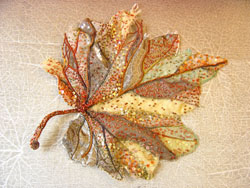Les Beaux Arts du Fil
Story of embroidery
The embroidery
It is probably necessary to go back to prehistory to meet the first embroidery. Certainly, they had nothing in common with those of today, but even then, they represented a personal wealth, a sign outside the social status of the wearer or the event for which we seem . Thus, the chief, the wizard or some other important member of the tribe was recognizable by the distinctive signs he wore on his clothes. Ivory pearls, fragments of bones, hair, colored or bleached leathers, pieces of fur, the raw material was at hand and plentiful, the richness of a model depending mainly on the creativity of its performer. However, one can not speak already of embroiderer, even if it is probable that a person particularly gifted for this activity is responsible for the realization of the most delicate motives.
All these successive discoveries allowed embroideries to beautify themselves and enrich themselves. However, it was not until the fifteenth and seventeenth centuries to know the peak of the embroidery because they are the centuries of splendor. Embroidery is a luxury that only a class of privileged can afford: the rich members of the royal family, the high dignitaries, the big bourgeoisie eager to display a certain grandeur, without forgetting the municipalities that received their distinguished guests with magnificence and the great church user who took advantage of the sometimes spectacular donations offered in devotion. Everything lends itself to embroidery, both women's and men's clothing, upholstery, and also furniture, the least trinkets, books, livery of servants, the harnessing of horses, coaches ... Nothing is forget it. The embroidery is extremely fine, silk, gold or silver, at the small point, in needle painting or couching. These noble materials and these delicate techniques mean that the number of hours necessary for the realization of the models and their prices are considerable.
The demand is so important that many workshops will be created. Colbert, promoter of large industries, opens the large manufactures, and at the same time prohibits textile products manufactured abroad, such as lace, embroidery and paintings painted in India, of which we shall speak in another chapter. In 1667, the Royal Manufactory of Crown Furniture opened its doors to the Gobelins under the authority of Le Brun, followed by the founding of the Saint Joseph Convent's embroidery workshop in Paris, which later contributed to the decoration of the castle. from Versailles, then to the castles of Noisy-le-Roi and Saint-Cyr (created by Madame de Maintenon). These workshops are not the only ones to embroider. Indeed, many convents where lace and embroidery have always been part of the monastic life, enjoy a reputation equal to or even superior to the most famous workshops, such as the Ursulines of Amiens. Also in 1770, Charles Germain de Saint-Aubin, embroiderer of King Louis XV, published the Art of the embroiderer, a book detailing the different styles and techniques of embroidery.
This craze for embroidery continues until the mid-eighteenth century. From then on, tastes change. Embroidered fabrics arrive from the East and Far East at very low prices. The petty bourgeoisie can now afford the luxury it has dreamed for so many years. But with this new explosion in the world of embroidery come to an end the centuries of splendor.
Lunéville embroidery
Lorraine has been for a long time a high place of embroidery. Since the fifteenth century there are elaborate patterns of colors, gold and silver, made by needle. The white embroidery - executed with white linen thread or muslin - appears in the eighteenth century and develops throughout the region. King Stanislas I, installed in Lunéville where he holds a brilliant court, promotes its growth. The French Revolution brings the whole country into a long crisis that will end thanks to the Empress Josephine, who is reviving the fashion of white embroidery. In 1805, there are in Nancy between 4,000 and 5,000 workers. In 1807, several workshops of young workers opened their doors. Some of these children, girls and boys, are only 7 years old. In 1811, the young ladies Cazottes embroider the veil of the cradle of the King of Rome.
The point of Lunéville, which since the nineteenth century owes its name to the city, is above all a chain bridge executed on tulle. We discover the possibility of using a hook to realize the point on a support stretched on a loom. With this technique, the speed of execution accelerates, the work is more precise, the patterns can be more delicate and the point much smaller. The fact of stretching the fabric on a loom gives the work a very beautiful finish: the fabric does not frown around the embroidered parts and it is no longer deformed by the manipulations. Many eastern cities embroider hook or needle on tulle or muslin evening but also on very fine linen or cotton such as batiste, percale or, less known nowadays, jaconas (cotton canvas intermediate between muslin and percale). The luxury white embroidery Lorraine is so famous that many houses have a subsidiary in Paris and as far as London and New York.
If the technique of embroidery has evolved, so is the embroidery itself. Blanche yesterday, she is now black or colored. However, the fame of Lunéville will come only in 1865 when Mr Ferry-Bonnechaux discovers the technique allowing to put the pearls and sequins using the hook. Success is immediate. In 1875, it is the vogue of black jet; in 1889, it is painted in all colors. In 1891, lighter and brighter sequins are also fashionable. It's a real flight of embroidery. Each year fashion has its requirements, so embroiderers must innovate, invent and propose new colors and patterns.
The war of 1914 will put a stop to this flourishing trade until 1918 when the crazy years shorten the dresses and cover them with pearls. Until 1928 the embroiderers worked tirelessly to satisfy the fashion, the city in the workshops, but also in the countryside where the workers work from home. The first apprenticeship school was founded in 1924.
Today, the Lunéville or needlepoint embroidery is mainly used for haute couture, luxury ready-to-wear, music hall and, more rarely, furniture. The big embroidery houses are in Paris. There are only a few in Lorraine.
La Haute Couture
Haute couture is undoubtedly born in France. Moreover, the French word haute couture is used worldwide. If France currently has the monopoly of fashion in Europe, yet until the nineteenth century there are no creators like the great couturiers. Fashion is dictated by the aristocratic and bourgeois clientele. These are the salons that set the tone. It was not until 1857 the arrival of a certain Charles-Frederick Worth who opened at No. 7 rue de la Paix a shop where he created his models. In two years, he became the appointed couturier of Empress Eugenie. It will contribute to the renewal of the Lyon silk industry. For the first time, a couturier dictates fashion and the rue de la Paix becomes the most elegant street in Paris.
In 1888 is created the Chambre syndicale de la haute couture française. It defines the rules to be applied by any fashion designer who wants to be recognized as a "fashion designer". For example, the number of annual parades, models, models for each collection, etc. Ready-to-wear will come into being in the 1930s under the leadership of a few fashion houses, but this phenomenon will really take off in 1960.
In 1970 appear the first stylists and, at the same time, it is the final break between ready-to-wear and haute couture. Begins a new era in the relationship between haute couture and fashion design.
Provençal embroidery
Since time immemorial, Marseille has been an open door to the world. The crusaders bring back the silks of the Orient, the cotton, the products necessary for the dyes and the painted canvases of India and Levant. These highly prized Indians are prohibited in the 18th century by Colbert. Their excessive price in contraband then pushes women to imitate them. From there are born the canvases embroidered in fine woolen thread at the Beauvais point. This point is nothing more than a very small chain stitch that emphasizes the features and fills the patterns. If the point used is unique, the colors are very varied. This chain is made using a hook. This prodigious work, however, is less popular than the paintings.
The “Boutis”
The dive, precursor of the boutis, is used as early as the 14th century in Italy and then in Provence. The technique consists of stretching on a loom a canvas of little value or pieced cloths which serve as a basis for the work. A layer of cotton wadding is placed on it and covered with a beautiful fabric. The drawing, if it consists of straight lines, is made using a wire coated with a blue powder stretched over the fabric and vibrated. For patterns or curves, the fabric is sanded before mounting on the loom. The three layers are joined by front points. The boutis, a specialty of Marseille and Western Provence, is a dive whose technique is to join the two fabrics by back stitches and then to introduce cotton wicks at the back of the work with the help of a needle. This technique makes it possible to create patterns of extreme finesse. Some of these boutis were embroidered at the bridge of Beauvais.
Cornely embroidery

The Cornely machine is none other than the direct descendant of the Couso-Brodeur of Monsieur Barthélemy Thimonnier, inventor of the sewing machine in 1830. It is a hook machine that makes a point of chain, he calls it '' The Couso-embroidery ''. Walter Hunt (American) bought the patent and created a needle movement and a shuttle. Isaac Singer will improve the mechanism in 1851 and sell the sewing machines for domestic use. It is a success.
A few years later, Mr. Cornely bought the first patent of B. Thimonnier and perfected the machine to make an embroidery machine. It will be used a lot, just like the Lunéville hook to embroider the mechanical tulles and gradually, she will take her nobility in haute couture embroidery. Today, it is found in almost all embroidery workshops.
Some important dates
- 1777 The Jacquard loom in England
- 1808 The tulle loom in France (tulle Bobin) The tulle will be embroidered with the hook to mimic the lace. We use the point of Beauvais and different points that use the networks of tulle to form patterns.
- 1865 Monsieur Ferry Bonnechaux de Lunéville to put beads on the embroidery thread.
- 1914-1918 World War I
- 1920 Roaring Twenties - Charleston Beaded Dress
- 1940-1945 World War II - invention of polyester
- 1950–1960 craze for plastic that allows all creations including glitter
- Along with the industrialization of the lace, will be born the first industrial embroidery machines such as multi heads.
History of sequins
The « paillons » sequins of antiquity were metal (gold or silver). They were too heavy to cover a garment and too expensive to be used by everyone. The little thing that covered a garment made him heavy, these clothes were essentially state clothes. You could also see some on hangings or cushions.
Bakelite sequins : invention of bakelite 1909 Bakelite is a product without flexibility and brittle it will not be used very long and will be replaced by gelatin cheaper and easier to work.
Gelatin sequins : used in the 1950s they are not resistant to washing because they melt in water and dry cleaning. It is still found today in vintage shops.
Polyester sequins : As early as 1960, polyester sequins will supplant gelatin sequins. They are light, cheap, washable and allow all colors and shapes.
LES BEAUX-ARTS DU FIL
9 rue du Commerce
85120 La Châtaigneraie
France
